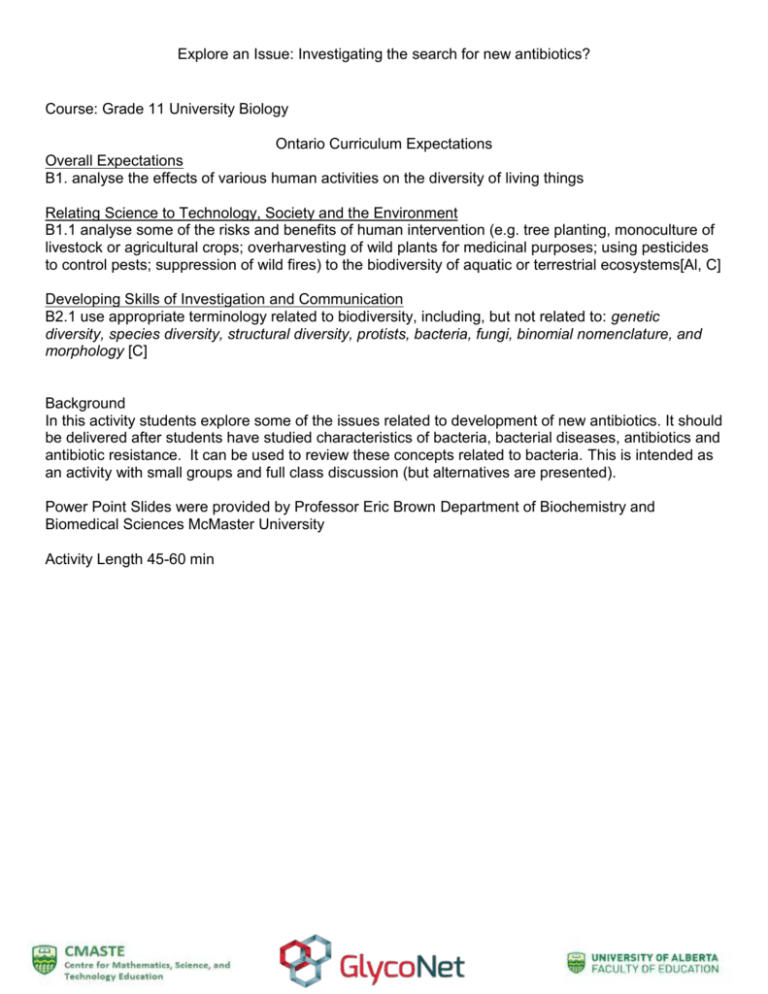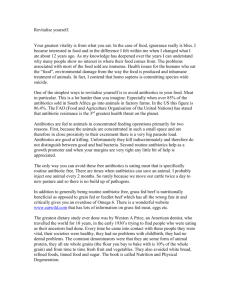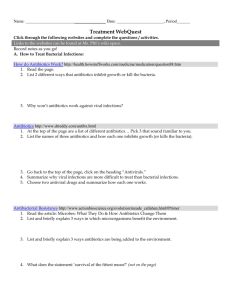Explore an Issue: New Antibiotics (TR)
advertisement

Explore an Issue: Investigating the search for new antibiotics? Course: Grade 11 University Biology Ontario Curriculum Expectations Overall Expectations B1. analyse the effects of various human activities on the diversity of living things Relating Science to Technology, Society and the Environment B1.1 analyse some of the risks and benefits of human intervention (e.g. tree planting, monoculture of livestock or agricultural crops; overharvesting of wild plants for medicinal purposes; using pesticides to control pests; suppression of wild fires) to the biodiversity of aquatic or terrestrial ecosystems[Al, C] Developing Skills of Investigation and Communication B2.1 use appropriate terminology related to biodiversity, including, but not related to: genetic diversity, species diversity, structural diversity, protists, bacteria, fungi, binomial nomenclature, and morphology [C] Background In this activity students explore some of the issues related to development of new antibiotics. It should be delivered after students have studied characteristics of bacteria, bacterial diseases, antibiotics and antibiotic resistance. It can be used to review these concepts related to bacteria. This is intended as an activity with small groups and full class discussion (but alternatives are presented). Power Point Slides were provided by Professor Eric Brown Department of Biochemistry and Biomedical Sciences McMaster University Activity Length 45-60 min Investigating the Search for New Antibiotics? ________________________________________________________________________________ Antibiotics have been crucial in preventing and curing bacterial infection. The development of the first antibiotics was revolutionary to medicine and in the twentieth century. In this activity we will explore the challenges to the present day search for antibiotics. 1. What do we know about antibiotics? Construct a concept map as a class or small groups to demonstrate your knowledge. Alternatively this could be a class discussion teachers should review the information and clarify any misconceptions regarding antibiotics 2. Watch the video-Attack of the Super Bugs from SciShow to review the major concepts related to bacteria, antibiotics and antibiotic resistance. https://www.youtube.com/watch?v=a-apdGwBPz4 10 min video that provides a quick overview of the scientific and historical perspective of bacteria and bacteria resistance 3. Complete the following chart highlighting a variety of antibiotics and where they act in the cell. There are a variety of antibiotics and they act to stop several processes in the cell. Teachers may choose to highlight… e.g. Penicillin one of the oldest of these antibiotics acts to prevent crosslinking in the cell wall. This damages the bacteria and prevents it from functioning other antibiotics act to inhibit folate synthesis, protein translation, and DNA replication many researchers are working find new targets to inhibit function in bacteria. Graphic Provided by: Prof. E Brown McMaster University Process or site of action Antibiotic DNA Replication Quinolones, Fluoroquinolones, Rifampicin Cell Wall Biosynthesis Glycopeptides, Penicillins, Carbapenems,Cephalosporins Folate Biosynthesis Trimethoprim, Sulfamethoxazole Protein Translation Macrolides, Chloramphenicol, Aminoglycosides,Tetracycline Reference: Silver, L. L. Clin Microbio Reviews, 2011. Provided by Prof. E Brown McMaster University 4. (a) During what 20 year time frame were the most antibiotics invented? 1940-1960 (b) During what 20 time frame were the least number of antibiotics invented?1990-present Other things to point out: Earliest discovery just prior to 1900 Penicillin discovered in the 1920’s Few discoveries before 1940 Highly concentrated development between 1945-1960 No new discoveries after 1990 5. Why do you think these trends exist?-can be generated individually/groups/as a class Answers will vary. 6. What are the implications for antibiotic resistance? -can be generated individually/groups/as a class. Some suggested responses include: We must rely on the existing antibiotics to deal with bacterial infections We are seeing bacteria that is resistant to antibiotics and if no more/few antibiotics are being developed we may be unable to treat these infections We may have to use existing antibiotics in combination (this is referenced in the video) 7. Research why have we seen this decrease in antibiotic development? Categorize your findings using a chart or other graphic organizer and be prepared to share your work with the class/other groups. Some suggested websites include: Canadian Journal of Infectious Disease and Medical Microbiology cited at the US National Center for Biotechnology Information http://www.ncbi.nlm.nih.gov/pmc/articles/PMC2095020/ Centre for Blood Research UBC http://cbr.ubc.ca/the-perils-of-a-future-without-effective-antibiotics/ New York Times http://www.nytimes.com/2015/02/24/opinion/how-to-develop-new-antibiotics.html?_r=0 Tufts University http://www.tufts.edu/med/apua/news/news-newsletter-vol-30-no-1-2.shtml World Health Organization http://www.who.int/bulletin/volumes/89/2/11-030211/en/ Video-Hunting the Nightmare Bacteria from the PBS show Frontline http://www.pbs.org/wgbh/pages/frontline/hunting-the-nightmare-bacteria/ Student work should include the following information There are three causes commonly cited for the discovery void… Scientific Some of the simplest forms of antibiotics have been discovered and sometimes rediscovered. It is becoming more complex to discover new antibiotics. This requires more sophisticated science to make a new antibiotic discovery which is costly and time consuming. Economic Drug companies do not see antibiotic research as good monetary return on the investment compared to other drugs. Bringing a new drug to market takes about 10 year and over $800 million in development costs Ideally a new antibiotic would only be used in the most difficult cases. Such an antibiotic would be used sparingly and not generate the amount of money necessary for drug companies to feel comfortable to invest in its development. Regulatory Issues The food and drug administration in the USA and other countries has made this form of drug approval difficult. There are many factors apart from the scientific that are contributing too few antibiotics being brought to the market. This demonstrates the idea that science is connected to the needs and priorities of the society in which it develops. 8. Considering what we know about the barriers to antibiotic development if …What can be done to encourage antibiotic development? Answers will vary but may include… Government funded initiatives More partnerships between university researchers, government and drug companies A review of the regulations that licence use of antibiotics to facilitate this process but still protect the public Safe and proper use of existing antibiotics





